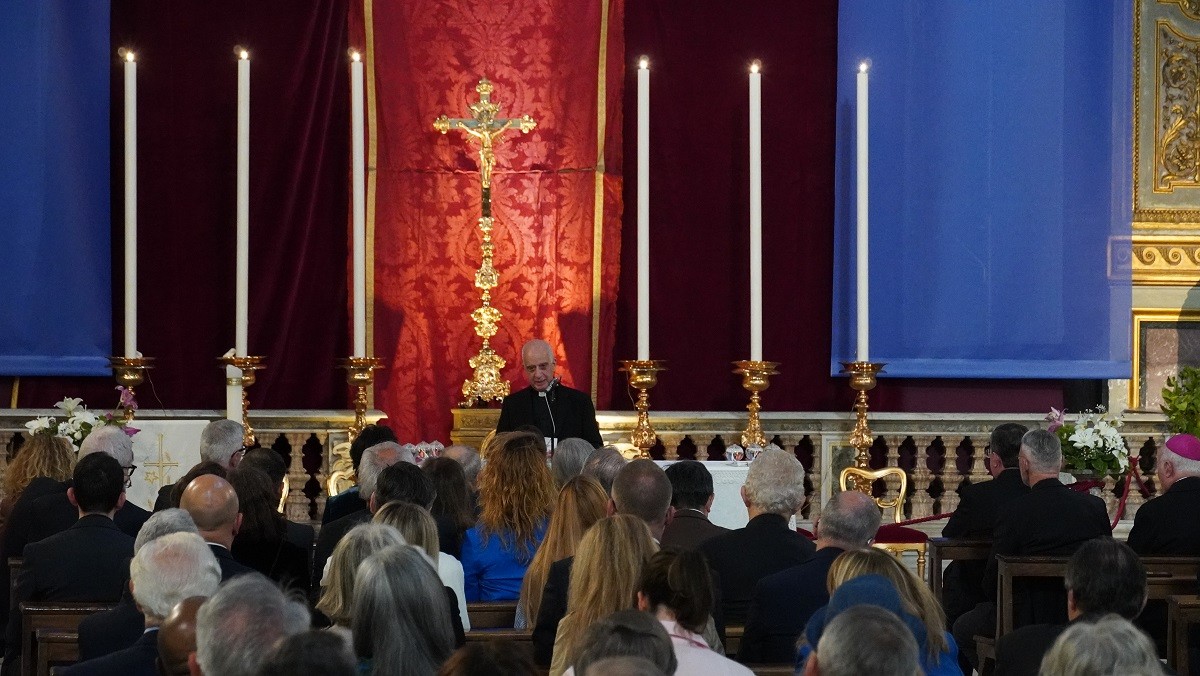Dalì's Christ is in Rome until 23 June at San Marcello al Corso for the ‘Jubilee is Culture’ season
“Salvador Dali's Christ has conquered the world. For us it is a joy to be able to think that many tourists, and many Romans will be able to come and contemplate this work because beauty really does allow us to live better.” That was the reaction of the Pro-Prefect of the Dicastery for Evangelization, Archbishop Rino Fisichella, at the inauguration of the exhibition ‘Dalì's Christ in Rome’. More than 2300 people attended the opening event of the exhibition in the church of San Marcello al Corso, in Rome, which is seens as a very important element of the ongoing ‘Jubilee is culture’ series of exhibitions, being held in preparation for the Holy Year.
In the Roman church, from 13 May to 23 June, the famous ‘Christ of Saint John of the Cross’, a work by the Spanish painter Salvador Dalì, will be exhibited for the first time next to the relic-drawing - an ink on paper sketch by Saint John of the Cross, from which Dalì took inspiration for his masterpiece. Archbishop Fisichella said: “The two works are deliberately displayed together, not only to give originality to the event - indeed this makes it unique - but above all to help people understand that beauty finds its deepest expression when it manages to bring a person to the contemplation of God. Those who have had a mystical experience, a particular encounter with God, can find themselves a source of inspiration for more beauty. Because where there is beauty, a person lives well, because his or her soul is inspired to go beyond its normal limits."
The Jubilee, explained the archbishop, as a spiritual event “is also a cultural experience. That’s why, following the publication of the Bull of Indiction of the Holy Year, entitled Spes non confundit, by Pope Francis, we wanted to organize this important event for the city of Rome. The Jubilee experience, in this way, can become a ‘door of hope’, and we hope that those who come through the entrance door of San Marcello will, by contemplating the crucifix, truly rediscover the Hope that we all need – especially at this time."
The curator of the exhibition, Don Alessio Geretti, then delivered an artistic interpretation of the works. “Dalì wanted to convey to us the certainty that, while the events of this world can overturn our lives, the cross of Christ, our hope, remains a solid reference point to which we can always return.” In the lower part, three figures are visible. The third figure, the most fleeting one, “sums up of all of us who, with a basket on our shoulders, with the fish collected from the fishermen, go home to feed someone. The same happens when we contemplate a work like this: we experience something that we can transmit to others."
What strikes a person first, however, is clearly the crucifixion scene above. “Our gaze rises and finds itself immersed in thick darkness, which partly represents that darkness in which the Word became flesh and then become the light of the world. But it is also the darkness of the first moment of Creation, when the spirit of God hovered over the waters and light did not yet exist."
The Christ who is seen suspended in the darkness "creates in us a sense of disorientation because he floats in the void and is seen from a bold and unusual perspective, which cannot be compared to any other famous image of Christ on the cross". Jesus is framed from above, almost as if the painter wishes to show and hide him at the same time. “We can’t even glimpse the face of the Redeemer, or understand whether he is alive or already dead. What also shocks us is that we can find no sign of physical pain in Him, no crown of thorns, no nails. There is nothing written on the scroll placed above his head, perhaps suggesting that we all write on that sign."
Observing the painting carefully, we cannot help but be struck by the unusual perspective, "not only daring but even considered wrong". Wrong “because in the painting two perspective vanishing points coexist which ought to be impossible in the same image. Christ offers a vision from the vertical, while the landscape offers one from the horizontal. Dalì was not the first to introduce two apparently incompatible perspectives into the same picture. This was something that the masters of Cubism had been doing for a while. They invented this angular decomposition of the figures not to complicate the image but to remind us that reality is more complex than it would appear from a single glance. Dalì uses this technique without any sharp fragmentation, making the two optically incompatible perspectives coexist in perfect harmony."
“The resulting effect,” continued the curator, “is of such harmony that we are not disturbed by it, as if Dalì were telling us that in the Christian perspective the divine and human gaze can find a way to come together serenely. In fact, we have to speak of a ‘divine gaze’, because Christ is seen from above as if from the viewpoint of the Father. It’s as if the Father is showing us His Son as He sees Him, hanging in the darkness of this world to give it that glimpse of light and salvation. For this, Dalì is indebted to the ‘Christ’ of Saint John of the Cross. In 1948, the Spanish artist visited the Monasterio de la Incarnación in Avila. While there he had the opportunity to see the very small drawing-relic that we have exhibited here in San Marcello, and which has never left the monastery. The two images were only together in Dali's mind but physically they have never been in the same place - until now. The original sight of that image struck Dalì to the point of inspiring his masterpiece. It’s as though, in that sketch of the saint, which came from his mystical experience, Dalì perceived that in Christ crucified lies hope for all the darkest nights of life and of the world".
The exhibition ‘Dalì's Christ in Rome’ can be visited every day, until 23 June, from 8am to 8pm, all day and with free entry, at the church of San Marcello al Corso, in Rome.


